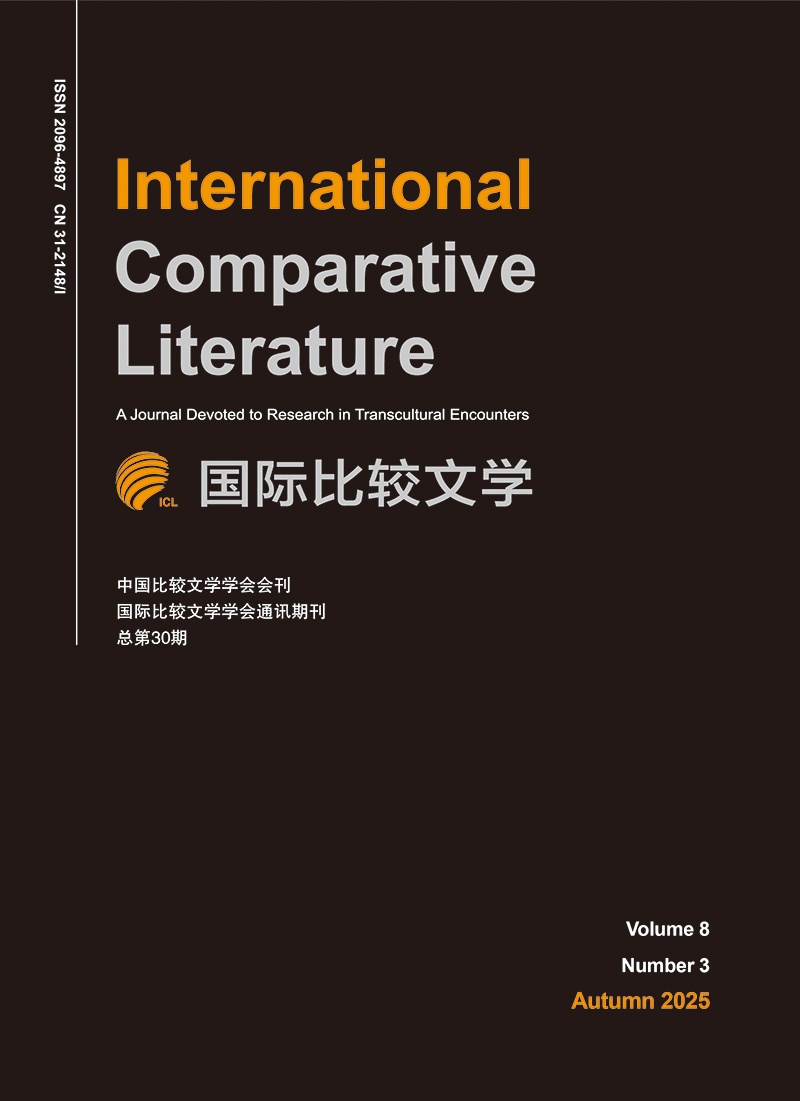|
[1]
|
CHENG Ching-mao.“The Impact of Japanese Literary Trends on Modern Chinese Writers.”In Modern Chinese Literature
|
|
[2]
|
in the May Fourth Era. Edited by Merle Goldman. Cambridge, Massachusetts: Harvard University Press, 1977.
|
|
[3]
|
Dazai, Osamu. Dazai Osamu: Selected Stories and Sketches. Translated by James O’Brien. Ithaca, New York: China-Japan
|
|
[4]
|
Program, Cornell University, 1983.
|
|
[5]
|
Keene, Donald. Dawn to the West: Japanese Literature in the Modern Era (Fiction). New York: Henry Holt and Company,
|
|
[6]
|
1984.
|
|
[7]
|
——. Landscapes and Portraits. Tokyo: Kodansha International Ltd., 1971.
|
|
[8]
|
Mertz, John.“Meiji Political Novels and the Origin of Literary Modernity.”PhD diss., Cornell University, 1993.
|
|
[9]
|
Miner, Earl. An Introduction to Japanese Court Poetry. Stanford: Stanford University Press, 1968.
|
|
[10]
|
Molasky, Michael, and RABSON, Steve. Edited. Southern Exposure: Modern Japanese Literature from Okinawa.
|
|
[11]
|
Honolulu: University of Hawai’i Press, 2000.
|
|
[12]
|
Rubin, Jay. Injurious to Public Morals: Writers and the Meiji State. Seattle: University of Washington Press, 1984.
|
|
[13]
|
Sakaki, Atsuko.“Kajin no kigū: The Meiji Political Novel and the Boundaries of Literature.”Monumenta Nipponica 55,
|
|
[14]
|
no. 1 (Spring 2000): 83-108.
|
|
[15]
|
Sansam, George Bailey. The Western World and Japan. New York: Alfred A. Knopf, 1949.
|
|
[16]
|
Sibley, William F. The Shiga Hero. Chicago: University of Chicago Press, 1979.
|
|
[17]
|
Torrance, Robert.“Modernism and Modernity.”Review of Dawn to the West: Japanese Literature in the Modern Era,
|
|
[18]
|
Volume I: Fiction; Volume II: Poetry, Drama, Criticism (1987) and The Pleasures of Japanese Literature (1988), by
|
|
[19]
|
Donald Keene. Journal of the Association of Teachers of Japanese 22, no. 2 (November 1988): 195-223.
|
|
[20]
|
ZHENG Guohe.“Politics of Canon Formation and Writing Style: A Linguistic Analysis of Kajin no kigū.”In The
|
|
[21]
|
Linguistic Turn in Contemporary Japanese Literary Studies. Edited by Michael K. Bourdaghs. Ann Arbor: Center for
|
|
[22]
|
Japanese Studies, The University of Michigan, 2010, 221-43.
|
|
[23]
|
芥川龍之介:《芥川龍之介全集》第15巻, 東京: 岩波書店, 1955。
|
|
[24]
|
[AKUTAGAWA, Ryūnosuke. Akutagawa Ryūnosuke zenshū (Complete Works of Akutagawa Ryunosuke). Vol. 15. Tokyo:
|
|
[25]
|
Iwanami shoten, 1955.]
|
|
[26]
|
千葉正昭:《太宰治と魯迅—「惜別」を中心として》,《国文学解釈と鑑賞》 48 (9) 1983年,第130-134页。
|
|
[27]
|
[CHIBA, Masaaki.“Dazai Osamu to Ro Jin”(Dazai Osamu and Lu Xun). Kokubungaku kaishaku to kanshō (June 1983):
|
|
[28]
|
130-34.]
|
|
[29]
|
太宰治:《太宰治全集》全12巻。東京:筑摩書房, 1989-1991.
|
|
[30]
|
[DAZAI, Osamu. Dazai Osamu zenshū (Complete Works of Dazai Osamu). 12 vols. Tokyo: Chikuma shobō, 1989-1991.]
|
|
[31]
|
井伏鱒二:《翻刻本の面白さ:『佳人之奇遇』につぃて》,《春陽堂月報》1930年6月第4期。[IBUSE, Masuji.“Honkokuhon
|
|
[32]
|
no omoshirosa: Kaijin no kigū ni tsuite”(Strange Encounters with Beautiful Women). Shun’yōdō geppō (Shun’ yōdō
|
|
[33]
|
Monthly) (June 1930): 4.]
|
|
[34]
|
五木寛之:《弱者の視点から》,《国文学 解釈と教材の研究》 21 (4), 1976年,第116-117页。
|
|
[35]
|
[ITSUKI, Hiroyuki.“Jakusha no shiten kara”(From the Perspective of the Weak). Kokubungaku: kaishaku to kyōzai no
|
|
[36]
|
kenkyū 21 (March 1976): 116-17.]
|
|
[37]
|
川村湊:《「惜別」論—「大東亜の親和」の幻》,《国文学 解釈と教材の研究》 36 (4), 1991年,第68-75页。
|
|
[38]
|
[KAWAMURA, Minato.“‘Sekibetsu’ron:‘daitōa no shinwa’no maboroshi”(On Regretful Parting: The Illusion of the
|
|
[39]
|
Amity of the Greater East Asia). Kokubungaku (April 1991): 68-75.]
|
|
[40]
|
ドナルド · キーン:《碧い眼の太郎冠者》,東京:中央公論社、1957。
|
|
[41]
|
[KEEN, Donald. Aoi me no Tarōkaja (A Blue-eyed Tarōkaja). Tokyo: Chūō kōronsha, 1957.
|
|
[42]
|
木村毅:《日米文学交流史の研究》,東京:講談社, 1982。
|
|
[43]
|
[KIMURA, Ki. Nichibei bungaku kōryūshi no kenkyū (A Study of the History of Japanese American Literary Exchanges).
|
|
[44]
|
Tokyo: Kodansha, 1982.]
|
|
[45]
|
権錫永:《〈時代的言説〉と〈非時代的言説〉—「惜別」》,《国語国文研究》 (96), 1994年,第30-43页。
|
|
[46]
|
[KON, Sokuyon.“‘Jidaiteki gensetsu’to‘hijidaiteki gensetsu’:‘Sekibetsu’”(The Discourses Fitting and Unfitting the
|
|
[47]
|
Times). Kokugo kokubun kenkyûū 96 (September 1994): 30-43.]
|
|
[48]
|
栗林秀雄:《志賀直哉》,福田清人編《人と作品》第30巻。東京:清水書院, 1968。
|
|
[49]
|
[KURIBAYASHI, Hideo. Shiga Naoya. In Hito to sakuhin (People and Their Literary Works). Vol. 30. Edited by Fukuda
|
|
[50]
|
Kiyoto. Tokyo: Shimizu shoin, 1968.]
|
|
[51]
|
桑原武夫:《文学理論の研究》,東京:岩波書店, 1967.
|
|
[52]
|
[KUWABARA, Takeo, ed. Bungaku riron no kenkyū (A Study of Literary Theories). Tokyo: Iwanami shoten, 1967.]
|
|
[53]
|
前田愛:《近代日本の文学空間》,東京:新曜社, 1983。
|
|
[54]
|
[MAEDA, Ai. Kindai Nihon no bungaku kūkan (Modern Japan and Its Literary Space). Tokyo: Shin’yōsha, 1983.]
|
|
[55]
|
中村光夫:《ふたたび政治小説を》,中央公論 74 (6), 1959年,第281-291页。
|
|
[56]
|
[NAKAMURA, Mitsuo.“Futatabi senji shōsetsu o”(Reconsidering Political Novels. Chūō kōron (May 1959): 281-83.]
|
|
[57]
|
——.《作品解説》,《 政治小説集》,《日本現代文学全集》第3巻,東京:講談社,1965年,第395-400页。
|
|
[58]
|
[——.“Sakuhin kaisetsu”(Introduction to Works of This Volume) to Seiji shōsetsu shū (Collected Works of Political
|
|
[59]
|
Novels). In Nihon gendai bungaku zenshū (Completed Collections of Modern Japanese Literature). Vol. 3. Tokyo:
|
|
[60]
|
Kodansha, 1965, 395-400.]
|
|
[61]
|
奈良本辰也,陈舜臣:《歴史対談 日本と中国:近代の幕明け》,東京:徳間書店, 1986.
|
|
[62]
|
[NARAMOTO, Tatsuya, and CHIN Shunshin. Nihon to Chūgoku: kindai no makuake (Dialogue: Japan and China, at the
|
|
[63]
|
Dawn of the Modern Period). Tokyo: Tokuma shoten, 1986.]
|
|
[64]
|
西田勝:《戦争と文学者:現代文学の根底を問う》,東京:三一書房, 1983年.
|
|
[65]
|
[NISHIDA, Katsuru. Sensō to bungakusha: gendai bungaku no kontei o tou (War and Writers: Digging the Roots of
|
|
[66]
|
Modern Literature). Tokyo: San’ichi shobō, 1983.]
|
|
[67]
|
野乃宮紀子:《惜別》,《国文学解釈と鑑賞 64 (9), 1999年,第119-124页。
|
|
[68]
|
[NONOMIYA, Noriko.“Sekibetsu”(Regretful Parting). Kokubungaku to kanshō (September 1999): 119-124.]
|
|
[69]
|
小田岳夫:《魯迅伝》,東京:筑摩書房, 1941.
|
|
[70]
|
[ODA, Takeo. Ro Jin den (A Biography of Lu Xun). Tokyo: Chikuma shobō, 1941.]
|
|
[71]
|
尾崎秀樹:《大東亜共同宣言と二つの作品》,《文学》 29 (8), 1961年,第20-38页。
|
|
[72]
|
[OZAKI, Hotsuki.“Daitōa kyōdō sengen to futatsu no sakuhin”(The Daclaration of the Greater East Asia and Two
|
|
[73]
|
Literary Works). Bungaku 29 (August 1961): 20-38.]
|
|
[74]
|
志賀直哉:《志賀直哉集》,進藤純孝、遠藤祐編《日本近代文学大系》第31巻,東京:角川書店, 1971.
|
|
[75]
|
[SHIGA, Naoya. Shiga Naoya shū (Collected Works of Shiga Naoya). In Nihon kindai bungaku taikei (Modern Japanese
|
|
[76]
|
Literature Series). Vol. 31. Edited by Shindō Junkō and Endō Tasuku. Tokyo: Kadokawa shoten, 1971.]
|
|
[77]
|
——.《志賀直哉选集》,《現代日本文学全集》第20巻,東京:筑摩書房, 1954.
|
|
[78]
|
[——. Shiga Naoya zenshū (Selected Works of Shiga Naoya). In Gendai Nihon bungaku zenshū (Complete Collection
|
|
[79]
|
of Modern Japanese Literature). Vol. 20. Tokyo: Chikuma shobō, 1954.]
|
|
[80]
|
鈴木修次:《中国文学と日本文学》, 東京:東京書籍株式会社, 1987.
|
|
[81]
|
[SUZUKI, Shūji. Chūgoku bungaku to Nihon bungaku (Chinese Literature and Japanese Literature). Tokyo: Tokyo shoseki kabushiki kaisha, 1987.]
|
|
[82]
|
高橋秀太郎:《太宰治『惜別』論》,《日本文学論考》, (1999.10), 第69-83页。
|
|
[83]
|
[TAKAHASHI, Shūtarō.“Dazai Osamu‘Sekibetsu’ron”(On Regretful Parting by Dazai Osamu). Nihon bungei ronkō
|
|
[84]
|
(October 1999): 69-83.]
|
|
[85]
|
太宰治:《惜别》,于小植译,北京:新星出版社, 2010年。
|
|
[86]
|
[TAIZAI, Zhi. Xibie (Regretful Parting). Translated by YU Xiaozhi. Beijing: Xinxing chubanshe, 2010.]
|
|
[87]
|
竹内好:《魯迅》,東京:日本評論社, 1944。
|
|
[88]
|
[TAKEUCHI, Yoshimi. Ro Jin (Lu Xun). Tokyo: Nihon hyōron sha, 1944.]
|
|
[89]
|
東郷克美,渡部芳紀:《作品論 太宰治》,東京:双文出版, 1974。
|
|
[90]
|
[TŌGŌ, Kokumi, and WATABE Yoshinori, eds. Sakuhinron: Dazai Osamu (A Study of Dazai Osamu’s Works). Tokyo:
|
|
[91]
|
Sōbunsha shuppan, 1974.]
|
|
[92]
|
德富蘆花:《蘆花全集》,东京:新潮社, 1928。
|
|
[93]
|
[TOKUTOMI, Roka. Roka zenshū (Complete Collection of Tokutomi Roka). Tokyo: Shinchōsha, 1928, 92-93.]
|
|
[94]
|
王向远:《“笔部队”与侵华战争》,北京:北京师范大学出版社, 1999年。
|
|
[95]
|
[WANG Xiangyuan. “Bibudui” yu qinhua zhanzheng (“The Pen Units”and Japanese Invasion against China). Beijing:
|
|
[96]
|
Beijing Normal University Press, 1999.]
|
|
[97]
|
柳田泉:《明治政治小説集 (2)》,《明治文学全集》,第6巻,東京:筑摩書房, 1967年。
|
|
[98]
|
[YANAGIDA, Izumi, ed. Meiji seiji shōsetsu shū (Meiji Political Novels). Vol. 2. In Meiji bungaku zenshū (Complete
|
|
[99]
|
Works of Meiji Literature). Vol. 6. Tokyo: Chikuma shobō, 1967.]
|
|
[100]
|
——.《佳人之奇遇と東海散士》,《政治小説研究 》第1巻,東京:春秋社, 1967年。
|
|
[101]
|
[——. ed.“Kajin no kigū to Tōkai Sanshi”(Kajin no kigū and Tokai Sanshi). In Seiji shōsetsu kenkyū (A Study of
|
|
[102]
|
Political Novels). Vol. 1. Tokyo: Shunjūsha, 1967.]
|
|
[103]
|
郑国和:《柴四朗〈佳人奇遇〉研究》,武汉:武汉大学出版社, 2000年。
|
|
[104]
|
[ZHENG Guohe. Chai Silang Jiaren qiyu yanjiu (A Study of Strange Encounters with Beautiful Women by Shiba Shirō).
|
|
[105]
|
Wuhan: Wuhan University Press, 2000.]
|

 点击查看大图
点击查看大图



 下载:
下载:

